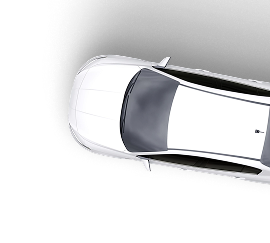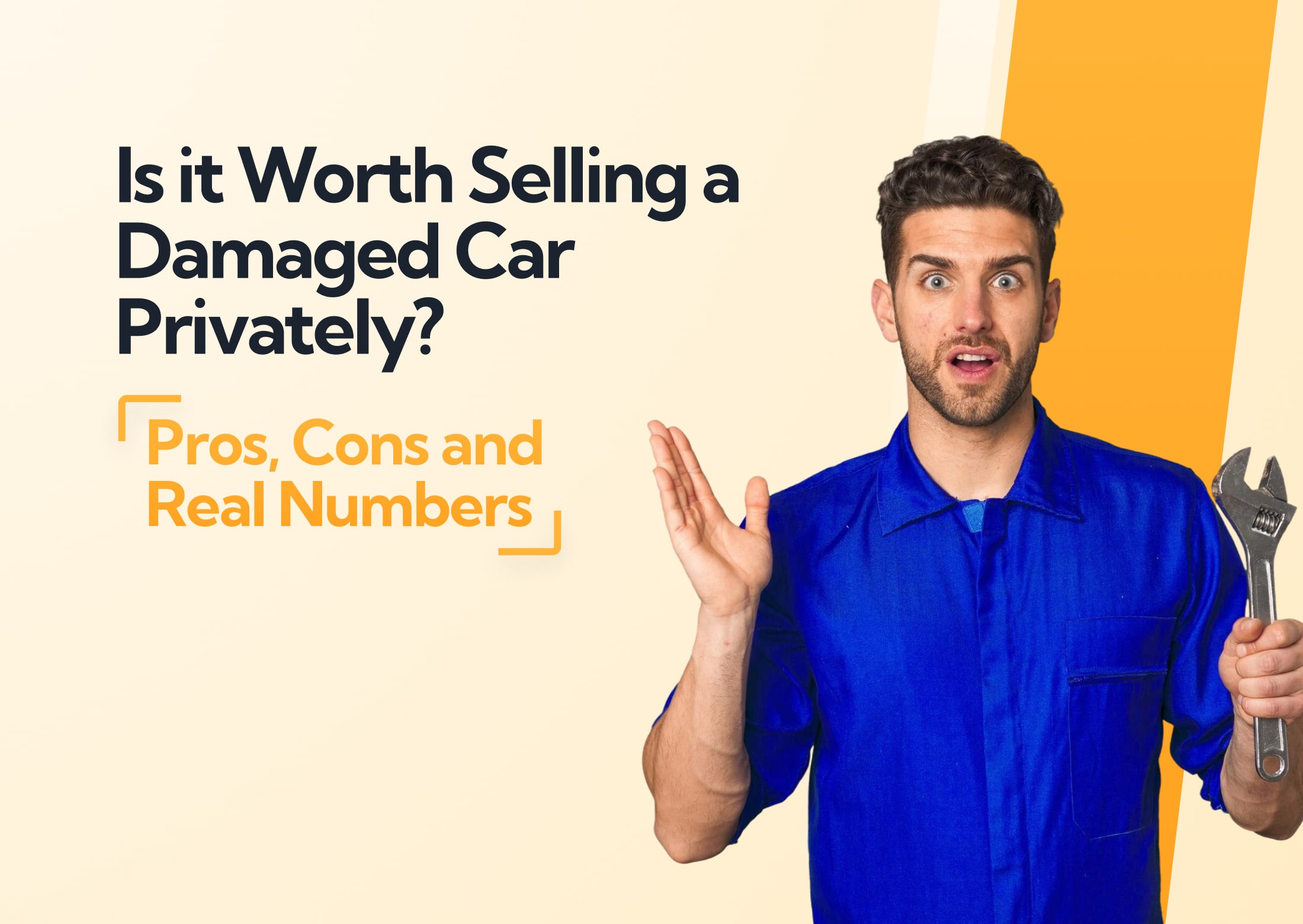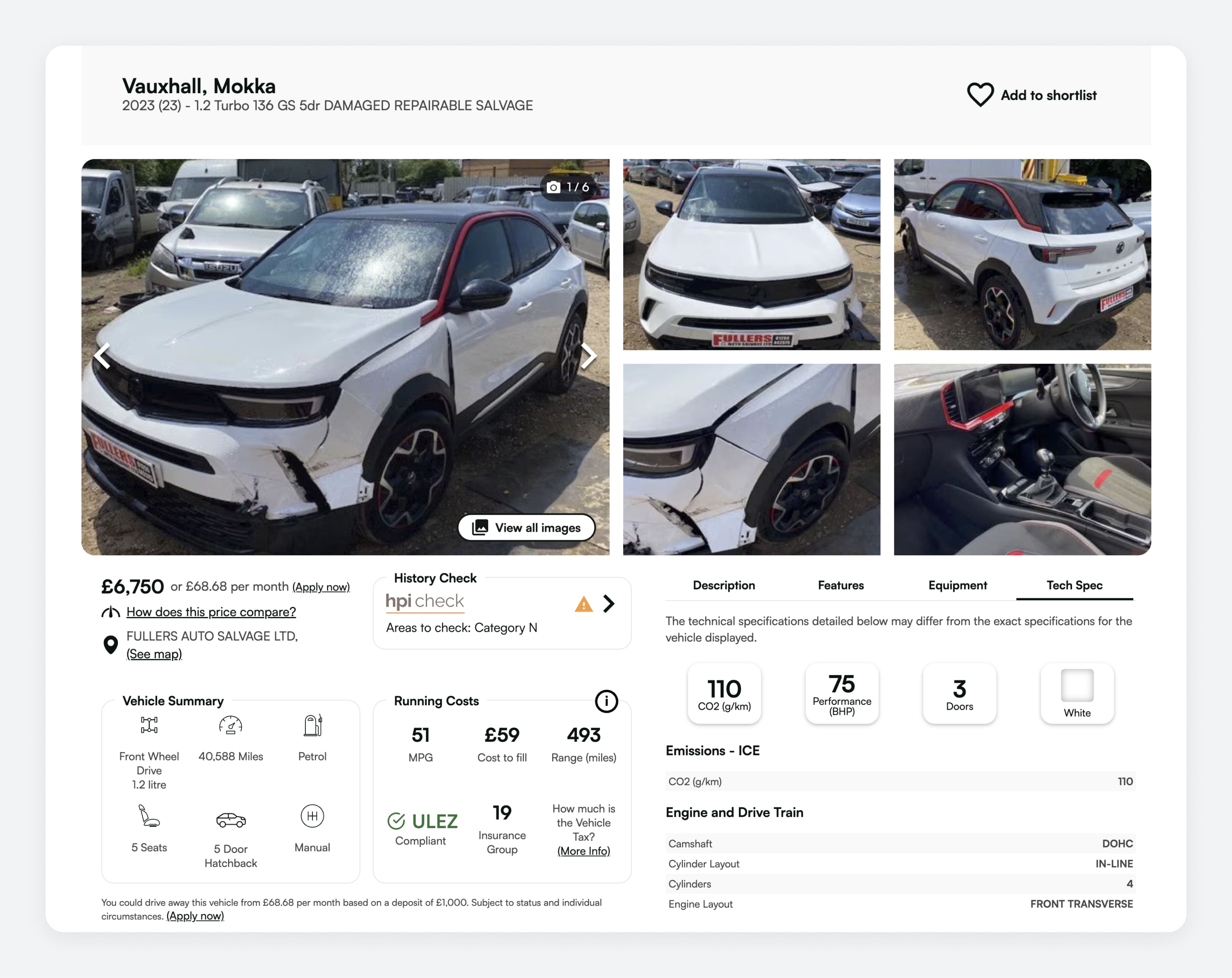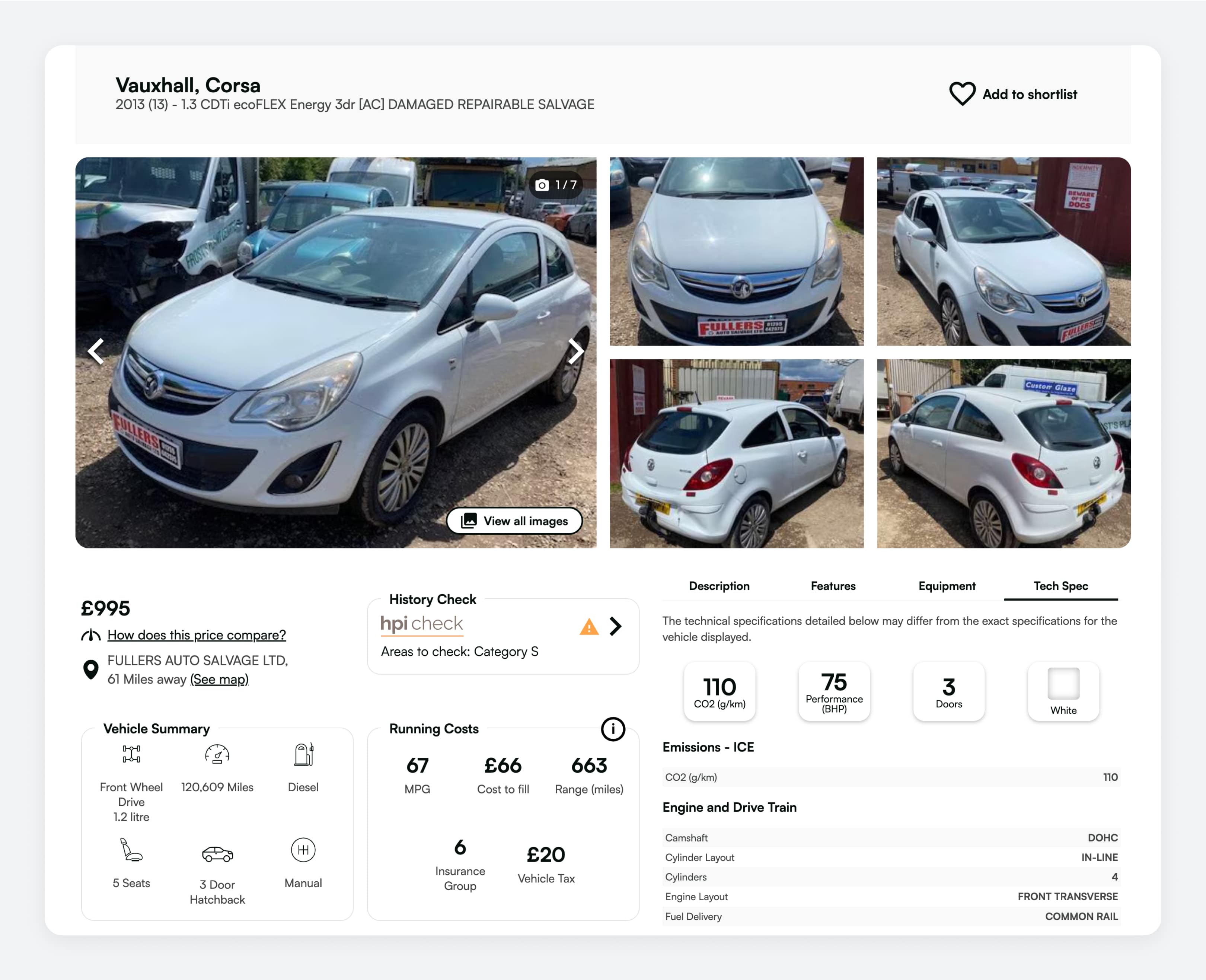Trade to trade car marketplace


Trade-only marketplace
Flexible selling options
Maximise your profits
Got a damaged car and wondering if it’s worth selling privately? This guide breaks down the pros, cons, legal must-knows and real-world pricing to help UK drivers decide. Learn how to get the most for your motor without getting burned.
Last updated: 4th August, 2025

Listen to this story
Selling a damaged car might feel like more hassle than it's worth, but that isn’t always the case. Doesn’t matter if the damage is cosmetic, mechanical or from an accident; there’s a buyer out there.
The question is: will selling privately get you more money, or just more stress?
In this guide, we’ll break down what’s involved in selling a damaged car on the private market. You’ll learn the pros, the cons and the key steps to take if you decide to go down this route.
Not all damage is created equal. Small cosmetic issues barely affect value, while functional issues make your car a tough sell.
Before you list anything, it’s important to understand how damage is classified both practically and legally.
Minor damage includes things like scratched paint, bumper scuffs or a cracked light. These are mostly cosmetic and don’t affect how the car drives.
Mechanical damage is more serious. Faulty brakes, engine trouble or a blown clutch will cost quite a bit more to fix. Not to mention, it’ll scare off buyers who don’t care too much about the aesthetics but are looking for something functional.
Structural damage is the most severe. This includes damage to the chassis, crumple zones, or anything affecting the car’s frame.
Even if they’re repaired, structural issues impact safety and value long-term.
If your car has been written off by an insurer and you’re able to sell it, it’s placed into one of two categories:
Being in a write-off category doesn’t make a car illegal to sell, but it does affect buyer trust. It will fetch significantly less than the equivalent with a clean title.
Not necessarily, but it does mean you need to be upfront.
An unroadworthy car can’t legally be driven on public roads until it’s fixed. This includes cars without a valid MOT with major safety faults or that have been declared off-road (SORN).
You can still sell the car as long as you clearly state the condition and don’t mislead the buyer. Many buyers are traders or hobby mechanics who specifically look for fixer-uppers. But they will need to arrange pickup and storage, since they cannot be driven or parked on public roads.
Selling privately takes more effort because you’re responsible for listing, managing potential buyers and facilitating the transaction. The tradeoff comes in the form of greater control over pricing and more money in your pocket at the end of the day.
Let’s take a look at why many UK car owners choose to go this route when parting with a damaged vehicle.
You’re likely to get more money selling privately than going through a dealer, scrapyard, or instant online valuation site.
The gap can be even wider if the damage is only cosmetic and the car still runs well. So, the better condition your car is in, the less financial sense it makes to scrap it or sell to a dealer.
You set the asking price. You choose whether to sell “as-is” or fix minor issues first to boost value. You’re not under pressure to accept a low offer on the spot.
Plus, private buyers appreciate clear listings with honest photos and a full description of damage. That transparency builds trust and gets you a better price.
When you go through a dealer, they’re mostly worried about their margins because they’re the ones who have to go through the trouble of reselling it. That means they’ll be less negotiable, especially if they think it might sit on the lot for a while.
The private market includes:
These buyers are harder to reach through trade-ins or scrap services, but they’re actively searching on platforms like Gumtree, Facebook Marketplace and eBay Motors day in and day out.
By cutting out dealers and selling directly, you avoid admin fees, auction charges and instant dropoffs in value. Every pound you negotiate is yours, which is why you’ll come out well ahead if you’re willing to put in a bit of grunt work.
While selling privately brings in more cash, it’s not all upside. There are some serious drawbacks to consider if the damage is extensive or you seriously need a fast sale.
Selling privately means doing the legwork yourself. You’ll need to take photos, write a proper listing, manage messages and deal with time-wasters. Viewings can also be inconvenient or even potentially risky if strangers are coming to your home.
Also, if the car isn’t roadworthy, you’ll have to arrange transport or be clear that it can’t be test-driven.
Under UK consumer law, private sellers must still be honest and not mislead buyers. If you knowingly hide major faults or fail to disclose insurance write-off status, you could be held liable after the sale.
You’re not expected to be a mechanic, but you are expected to answer questions truthfully and present the car as described. A written “sold as seen” agreement helps, but it won’t protect you if you’ve been deliberately dishonest or careless with the facts.
There’s a market for damaged cars, but not for every kind. If the engine’s blown, the frame’s bent, or it won’t start at all, you’ll only attract specialist buyers like breakers or exporters. These buyers exist, but they’re harder to reach and pickier about pricing (because they know they can be).
The more severe the damage, the fewer people will want the car and the longer it may take to change hands.
If you need the car gone ASAP, a private sale probably isn’t your best option. Scrap services and online buyers can collect the car within 24 to 48 hours. Selling privately, on the other hand, might take days or even weeks.
If time is money or the car’s taking up space on your drive, that delay could outweigh the financial benefit.
Alright, let’s cut to the chase. How much can you actually get for a damaged car?
Here’s a simplified breakdown using a common example: a 2022 72 Ford Fiesta Active X 1.0T with damage to the front bumper and a Cat S write-off. It’s currently listed for £5,450 and has 27,305 miles on it.

Let’s break down what this seller might realistically fetch if they were to sell it elsewhere:
| Sale method | Estimated offer | Notes |
| Private Sale | £4,750 - £5,500 | Best return if you can wait. Appeals to DIYers and body shops. |
| Auction (e.g. Trader.co.uk, Synetiq) | £4,000 - £4,800 | Quick sale. Buyers include salvage specialists. Fees apply (~£100-300). Competition affects the final hammer price. |
| Dealer Trade-In (as salvage) | £2,500 - £3,500 | Comparatively low offer. Dealers deduct repair costs and margin risk. |
| Scrappage (Car.co.uk) | £250 - £500 | Only viable if the frame is too far gone. Payment based on weight and parts. |
In this instance, while it is damaged, the repair costs for a DIY buyer or someone with workshop access would be around £2,000 to £2,500 and its resale value as a low-mileage newer model would be around £8,000 to £10,000.
Since it’s worth it for someone to buy, it’s worth it for this seller to sell on the private market. Had the car been more severely damaged with higher mileage, the scale probably would have tipped in the other direction.
Award-winning CEO driving growth and social impact across automotive, recycling, and technology-led enterprise platforms.
We see a lot of sellers underestimate what their damaged car is actually worth. If it still drives, that’s even more true. The private market is full of mechanics and resellers looking for value others don’t see (or simply don’t care about). If you’re honest in your listing and price it right, more often than not you’ll beat trade-in or scrappage offers by a mile.
Not all damaged cars are valued equally. The price you’ll get depends on the make/model, age, mileage and type of damage.
Popular cars like the Ford Fiesta, Volkswagen Golf, and Vauxhall Corsa hold value even when damaged because there’s strong demand for parts and repairable stock. Luxury or niche vehicles might have higher resale potential if the right buyer comes along. But parts are more expensive and fewer people are qualified to fix them.
A newer car with low mileage is worth more because it has more usable life ahead.
A five-year-old car with 50,000 miles will always sell better than a fifteen-year-old one with 150,000 miles, even if the damage is similar. At a certain age, older high-mileage vehicles are usually only bought for parts or scrap, which caps their value.
This is where things get specific:


When you sell any car, you have to account for the costs of transport, listing and possibly fines and legal fees if you don’t do the paperwork correctly.
If the car isn’t roadworthy, you can’t legally drive it to a buyer. You’ll need to hire a recovery truck or towing service and arrange for collection at your own expense (unless the buyer handles that). Expect to pay £50 to £150 for each depending on distance.
Some platforms charge to list or promote your car:
You might also want to pay for photo upgrades or ad boosts.
Even if you don’t plan a full repair, small jobs like…
...can make a big difference to sale value. But they’ll cost you £50 to £250 upfront depending on the job.
You’ll have to:
These are all free to do. But if you don’t do it properly, you will be liable for fines and parking tickets long after the car’s gone.
It’s not a direct fee, but your time is worth something. Answering questions, arranging viewings, and dealing with no-shows takes hours. And if the sale drags on for weeks, you may still be paying insurance, storage, or tax on a car you’re not using. Always factor in the opportunity cost.
Your listing should be upfront and accurate. That means:
Never try to hide faults. For one, it’s illegal. But it’s also flat-out unethical to withhold that information (and it’s easy to find with a vehicle history check).
Here’s an example of a solid listing:

The header is descriptive and “DAMAGED” is front and center, impossible to miss. It’s also clear on what else the car has to offer and has a verified HPI Check so the buyer doesn’t have to get one themselves.

And it’s got all of the specs at the bottom.

Essentially, you want to be as descriptive as possible, highlighting the benefits of the car without avoiding the fact it’s damaged.
Each platform attracts a different type of buyer. Choose based on how fast you want to sell and how involved you want to be.
| Platform | Pros | Cons | Best for… |
| Trader.co.uk | - Free to list - Trusted by the trade - Fast sales to dealers | Trade-only buyers | Quick disposal of damaged, end-of-life, or unwanted vehicles |
| AutoTrader | - Trusted platform - Attracts serious buyers | - Listing fees from £39.95 - Slower for fast sales | Higher-value cars with cosmetic or minor damage |
| eBay Motors | - Auction format can increase price - Wide national reach | - Final value fees apply - Time-wasters possible | Damaged but desirable models; project cars |
| Facebook Marketplace | - Free to list - Quick local responses | - Lots of no-shows and low offers - Less buyer accountability | Cheap damaged cars; local fixer-uppers |
| Gumtree | - Free or low-cost listings - Popular with DIYers and exporters | - Poorer platform moderation - Limited exposure outside local area | Parts cars, SORN vehicles, or repairables |
Pro tip: If the car is a write-off or needs major work, include keywords like “spares or repair”, “Cat S” or “non-runner” so the right buyers find it.
Always meet in a public or secure location, ideally during daylight hours and with someone else present if possible.
When your buyer comes for a viewing, point out the issues in person so they can make a more educated decision. If it isn’t roadworthy, let the buyer know in advance so there’s no expectation of a test drive.
Make sure to keep the keys with you until payment is complete.
To legally transfer ownership, you must:
Also give the buyer a written “sold as seen, tried and approved without guarantee” receipt. This clarifies the condition and that they’ve accepted it knowingly.
In some situations, the time, effort, and risk involved in selling a damaged car privately simply aren’t worth it. If any of the following apply to you, you might want to skip the private sale and go straight to a dealer, trader, or scrappage firm:
In other words, if your main goal is speed, simplicity and a stress-free disposal, you’re better off making less from the sale and getting rid of it faster.
You’ve got options beyond selling your car privately, many of which are a lot faster and more convenient than doing it yourself. Depending on its condition, one of them might be a better fit.
Services like Motorway, WeBuyAnyCar and CarTakeBack offer fast quotes and hassle-free collection. Some inspect your car on the spot, others ask for photos and a description before making an offer.
The best part about these companies is that working with them is quick, convenient, no advertising required. Offers are lower than private sales, though, and some will deduct money after inspection.
They’re best when your car has light to moderate damage and you need a fast, simple sale.
You can list your car in a public auction or through a trade platform like BCA or Trader.co.uk. Bidding creates competition, which can help boost the price.
When you sell your car at an auction, you’re getting wide exposure to traders, mechanics and exporters. Listing and success fees apply and the sale price isn’t guaranteed, but it’s a way to potentially get as much from the sale as you would selling it privately, but much faster.
Auctions are best for damaged cars with resale potential or niche appeal.
Some garages and independent mechanics buy damaged cars for spares or to fix and flip. You can also dismantle the car yourself and part it out individually.
If you know what you’re doing, this can be profitable. But it’s time-consuming and not a great fit if you don’t have the technical know-how or storage space.
Cars with rare parts or valuable components (e.g. engines, gearboxes, alloy wheels) are best sold for parts when the car on its own doesn’t function properly.
If the car’s beyond repair, scrapping is often the simplest route. Licensed scrap dealers will collect the vehicle, handle DVLA paperwork and pay based on weight and recyclable parts. Make sure the scrap dealer is an Authorised Treatment Facility (ATF). They’ll issue a Certificate of Destruction (CoD), which proves you’re no longer the registered keeper.
This is the way if your number-one priorities are fast removal, minimal effort and free collection. But it also gives you the lowest possible return (usually £200 to £400 depending on the vehicle).
If your car’s a non-runner, it’s flood-damaged or is a high-mileage write-off, it might be worth considering.
Selling a damaged car privately in the UK is a smart and profitable move if you’re realistic about the process. You’ll get more money than a dealer or scrap yard will offer, especially if the car still runs or the damage is minor. But you’ll need to put in the effort: honest listings, careful communication and proper paperwork.
It’s not for everyone. If you’re short on time, dealing with a non-runner or just want the thing gone, there are easier routes. Still, for the right car and the right seller, going private can mean hundreds more in your pocket.
Just be straight with buyers, stay safe during viewings and don’t overthink it. The damaged car market is alive and well. You just need to play it smart.
No. Cat S cars have structural damage. You must have them professionally repaired and re-registered with the DVLA before you can legally sell them on. There are no exceptions to this rule.
Yes. You’re legally required to disclose any known faults when you sell your damaged car. This especially applies to major ones like write-offs. Hiding damage, whether cosmetic, mechanical, or structural, can lead to legal trouble down the line.
If you’ve lost your V5C logbook, we strongly recommend getting a new one before selling your car. Most buyers won’t go near a car without the V5C. Use DVLA form V62 to request a new one. It costs £25 and takes around 2 to 4 weeks.
Yes, but there’s nuance. You can sell a non-runner, but you must clearly state that the car doesn’t start or drive. It can’t legally be driven away, so the buyer will need a trailer or recovery truck.
It depends on the damage and the buyer. Traders often prefer buying as-is because they can source parts or labour cheaply. But if it’s a small, affordable fix (like a bumper dent or cracked mirror), sorting it out first can add £200 to £500 to your price.
Most of the time, no. Private car sales in the UK are final under the Sale of Goods Act as long as you’ve been honest. You’re not a business, so consumer return laws don’t apply. Get a “sold as seen” receipt and don’t deliberately hide any major faults, and you’ll be fine.

